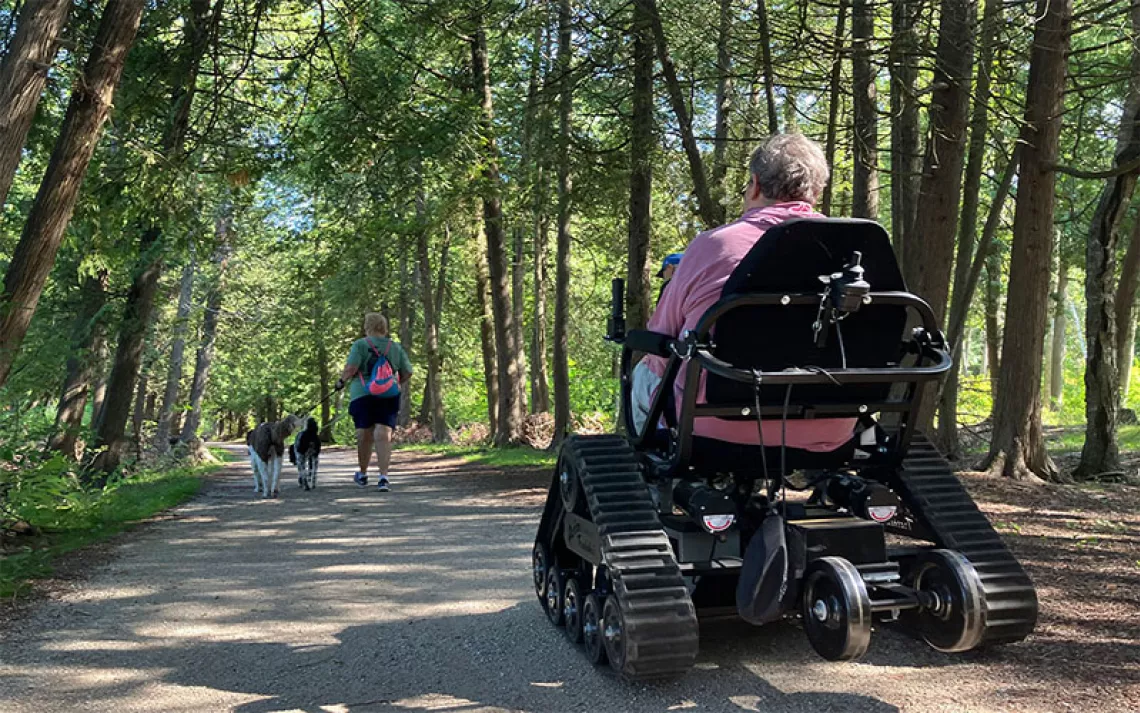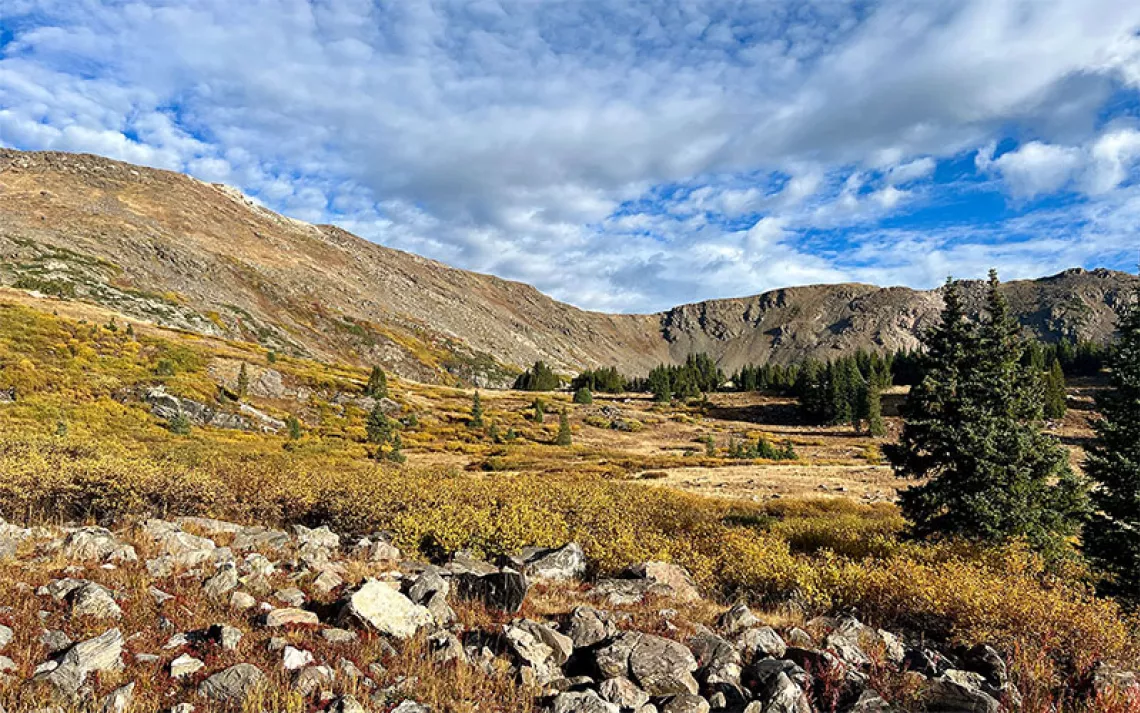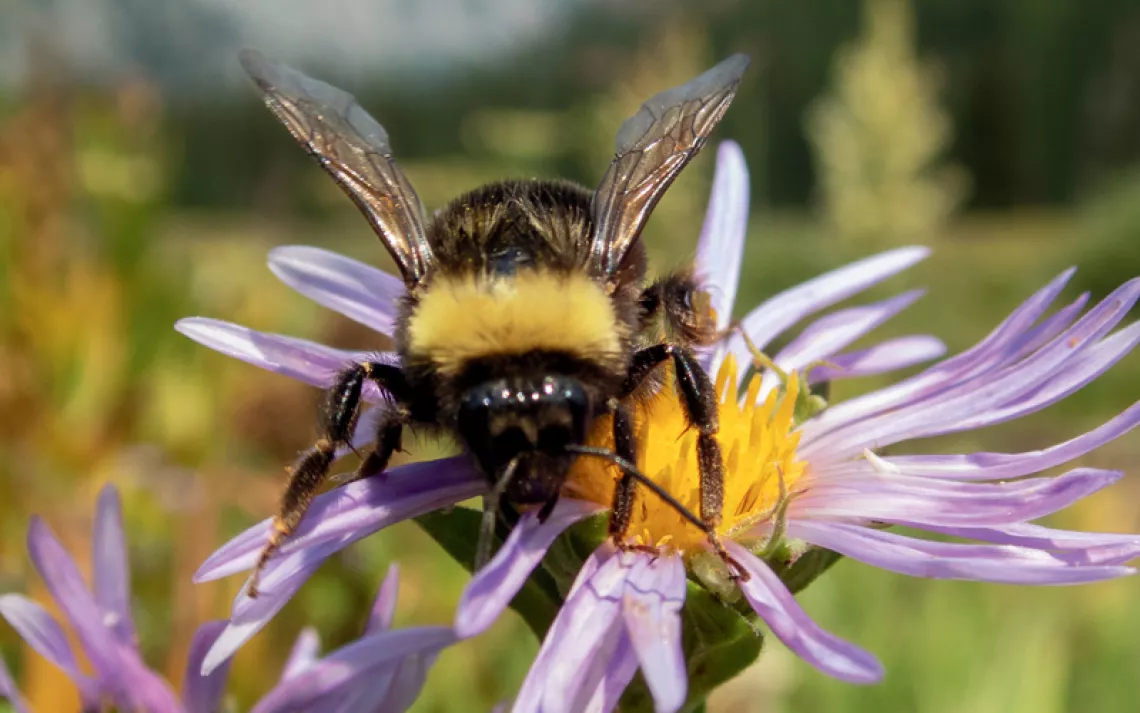Searching for Life in Tombstone
In Tombstone Territorial Park, the weather is mercurial and the wildlife thrives
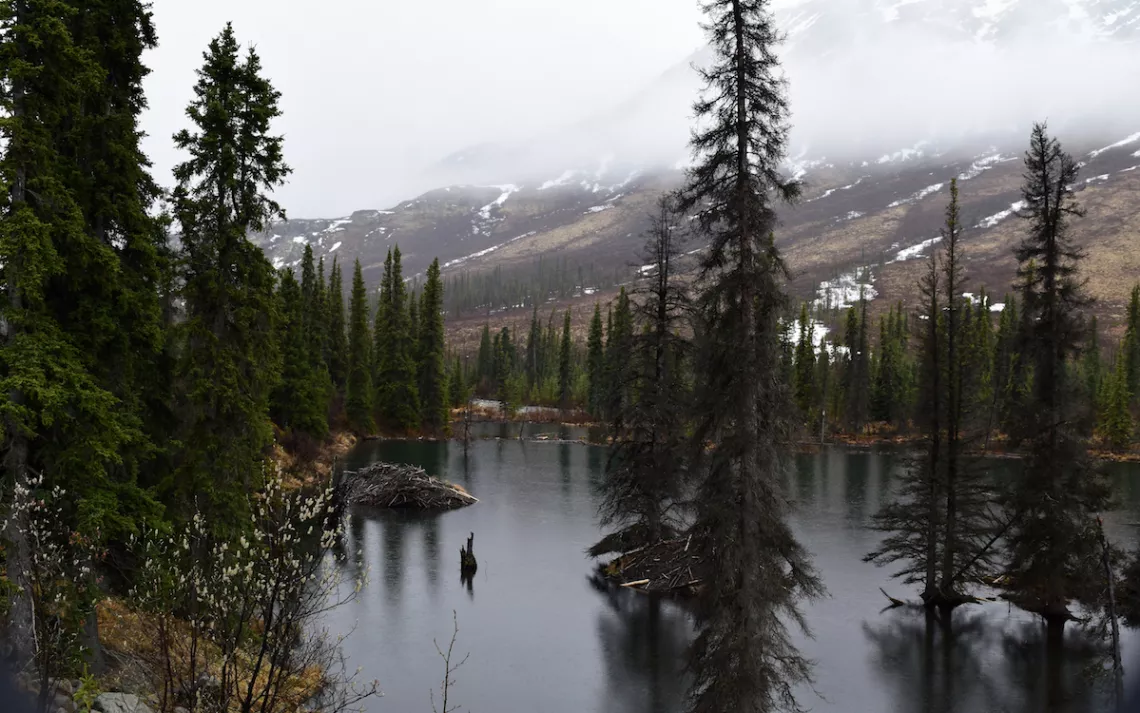
Trees with dark pond | Photos by Ryan MacDonald
My feet squish down into spongy, brittle reindeer moss as I trek along the banks of the North Klondike River in Canada’s Tombstone Territorial Park. I make my way down an unmarked trail, one that slowly tapers away and disappears underneath a cluster of willow bush shrubs. The sloshing of icy river water that recently broke after a long winter’s freeze pierces the silence of the still tundra landscape.
To comfort myself, I begin to laugh out loud like a witch cackling under the glow of a full moon, even though there’s nothing funny about this moment.
A few hours earlier, upon entering the park’s border, I spotted a black bear moseying across the main road, its fur glistening after bathing in a nearby stream. This is “grizzly country” after all, so when I told a ranger about my encounter, my fear was real. But she calmed me down and advised me to laugh or sing while hiking to scare off bears that might be just waking up from hibernation.
“Duly noted,” I said as I passed her a $20 bill in exchange for a can of bear spray, something I hoped would protect me in case my laughter wasn’t enough.
Normally I’m not this frightened out on the trail, but this trip is different. I’ve come to the park all by myself. A solo-backpacking trip is something I’ve always wanted to do, and what a park I’ve chosen to accomplish this goal.
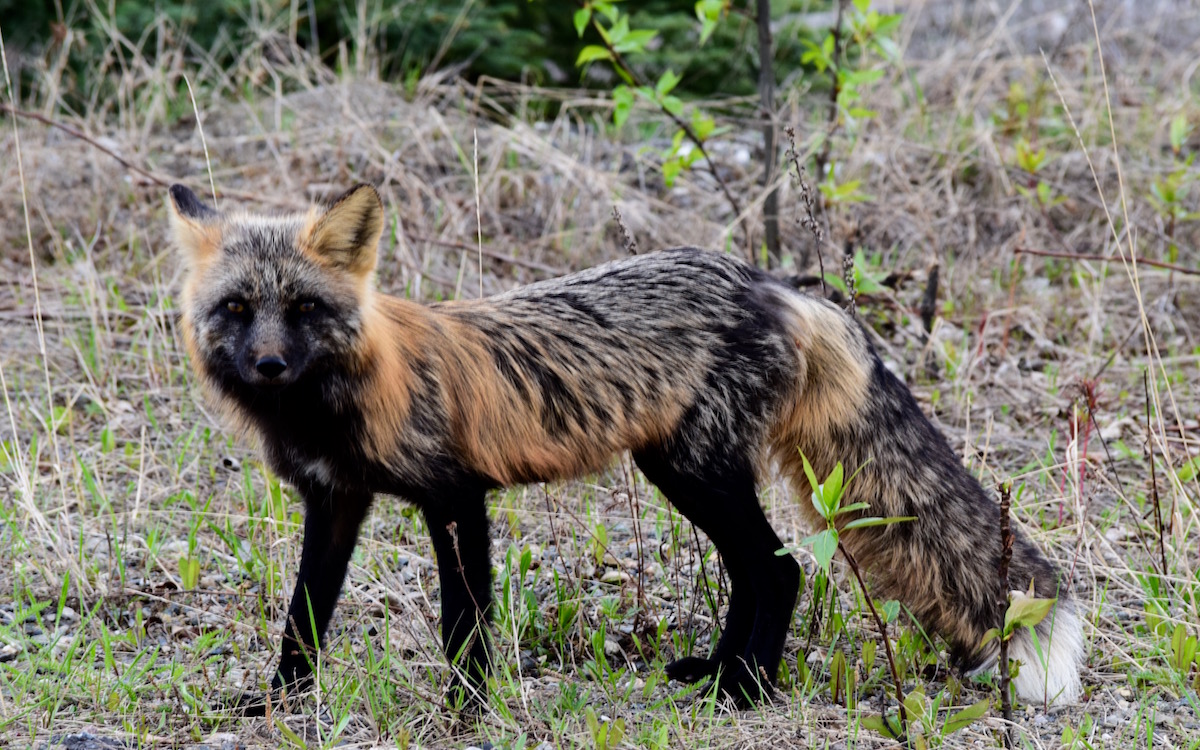 Located in the northwestern corner of the Yukon Territory, Tombstone Park is a sprawling, raw wilderness of 2,000 square kilometers, where the services are limited, the weather is mercurial, and the wildlife thrives. The landscape spans boreal, alpine, and arctic environments, and it’s home to the Ogilvie Mountains, a range of jagged peaks, and a diverse population of caribou, moose, eagles, and black and grizzly bears.
Located in the northwestern corner of the Yukon Territory, Tombstone Park is a sprawling, raw wilderness of 2,000 square kilometers, where the services are limited, the weather is mercurial, and the wildlife thrives. The landscape spans boreal, alpine, and arctic environments, and it’s home to the Ogilvie Mountains, a range of jagged peaks, and a diverse population of caribou, moose, eagles, and black and grizzly bears.
The park is a protected territorial land, too, and it remains one of the most important hunting sites for the Tr’ondek Hwechi’in First Nation people who have subsisted for thousands of years on the resources found here.
It can take up to three hours to reach the nearest town, so visitors are warned to come prepared for anything when they turn onto the Dempster Highway—an unpaved road constructed in 1979 by the Canadian government that bisects the length of the park—and make their journey north.
I was one of the first visitors of this season when I arrived in late spring. The backcountry trails were still closed, so the ranger said I could make my own trail as long as I kept an eye on where I was going.
“Just find a spot along Dempster and head out into the open,” she told me. I peered at the topographic map that she was pointing to and tried not to be overwhelmed by all my options.
But forging a trail on the tundra is tougher than it seems. I march on top of the bumpy and uneven permafrost ground in a slow and methodical manner. Mud splatters around the rubber soles of my boots, and in the middle of this unmarked nothingness, I notice that even the spruce trees struggle to stay upright. With their roots tenuously planted into this frozen soil, their trunks tilt at an angle. So odd looking, it’s like nature’s playing a joke on all of us.
I ascend a small slope and climb up onto some granite boulders, where I’m hoping to catch a glimpse of the park’s namesake peak, which can be seen through the Klondike River valley, even though it’s 15 miles away. In the middle of what could be five or six football fields, where in every direction there’s a monochromatic palate of brown-, gray-, and tan-colored things that blend together in the dull afternoon light, I feel like I’m in a dream, infinite and neverending.
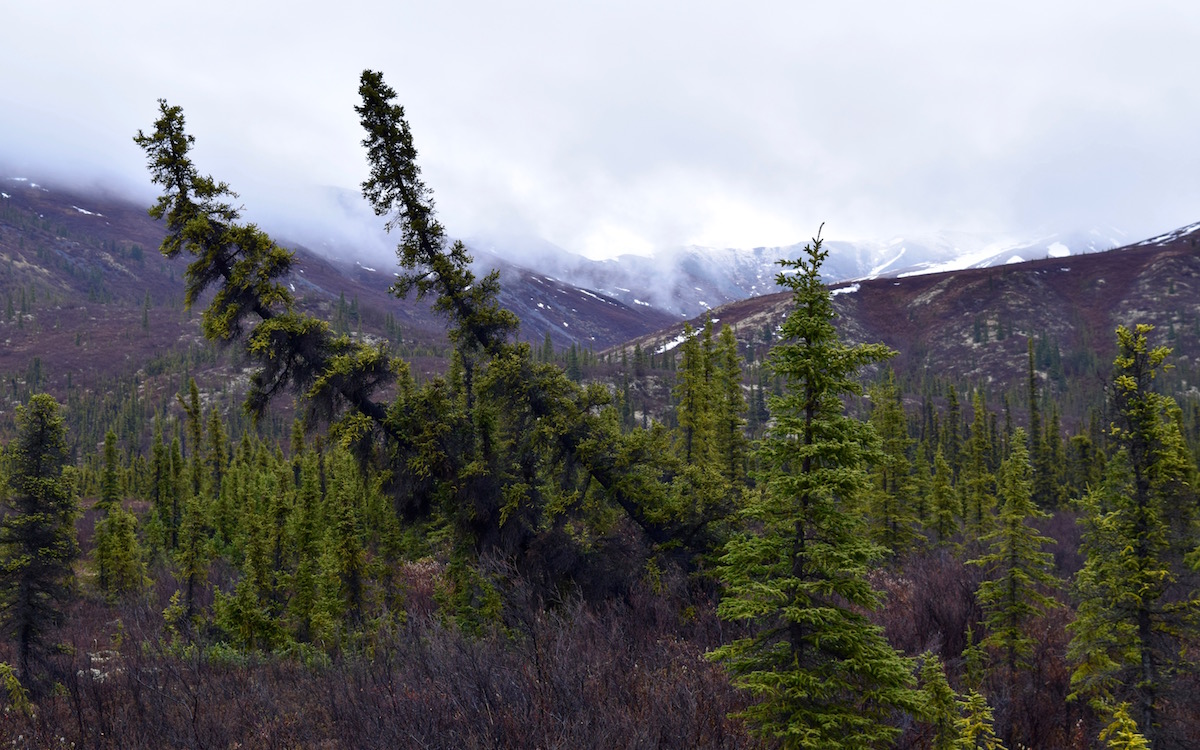
With my finger, I trace the ridge of a mountain, where the boreal forest has thinned out below, and the snow and scree-covered peaks tower over me. A moody veil of slow-moving clouds hovers in the distance and keeps Mt. Tombstone hidden.
Back at camp, I crawl into my tent and scroll through old photos and videos of my dogs to keep me company. Usually my friends and I stay up late after a long hike, reminiscing about our favorite moments from the day, but tonight I drift off to sleep quickly without any sort of reflection. When I wake to a choir of birds, chirping in their best soprano range, I check my watch, thinking it’s morning. It’s only 2 A.M. and still light out. The “midnight sun,” a time of year when it stays light until after midnight and beyond, has fooled me and the birds into thinking it’s time to get up. I cover my eyes with my bandanna and roll over back to bed.
A few hours later, when I do actually wake up for the day, I stop at an outhouse and notice something scribbled inside the stall.
I was here, Here I was.
Was I here? Yes I was!
The poem’s simplicity, almost haiku-like, lingers in my mind. It reads not only like an ode to Tombstone and my experience, but also an ode to all our favorite parks and national monuments that capture our imagination with their surreal beauty and mystical qualities.
Someone, if only a stranger, shared this moment with me, I realize. And the writing is on the wall.
Where: Tombstone Territorial Park, Yukon Territory, Canada
Getting There: From the capital of Whitehorse, fly to Dawson City, the nearest town, and drive two hours north along the Dempster Highway. There are no services or lodgings along the road. The Tombstone Interpretive Center is located at kilometer 71, where you can find out information about the park and your visit.
Best Time to Visit: The backcountry trails open at the ranger’s discretion, which is usually by June 21. By then, the arctic wildflowers will have started to come into full bloom. During the summer months, visitors will experience daylight almost around the clock, so hiking long trails and routes is possible.
Permits: With less than five established trails in the park, reservations are required for backcountry hiking during the peak season (June to September). Early reservations are recommended and can be made online. The backcountry sites come equipped with tent pads, an outhouse, and a cooking platform.
Survival Tip: Both grizzly and black bears are often spotted in and around the park, so being “bear aware” is necessary during your stay. Bear spray and canisters can be rented for a small deposit at the interpretive center.
Wildlife Spotting: Home to migrating caribou, bears, moose, sheep, eagles, falcons, butterflies, and countless other species, the open and expansive tundra is ideal for spotting a variety of wildlife. Porcupine caribou migrate through the park during spring and fall and can be seen along Dempster Highway as the herds move between breeding grounds in the north and south.
 The Magazine of The Sierra Club
The Magazine of The Sierra Club
